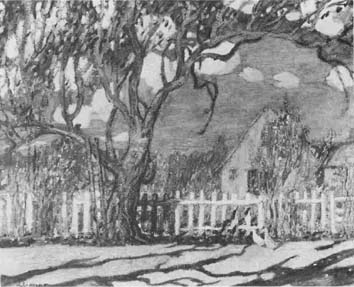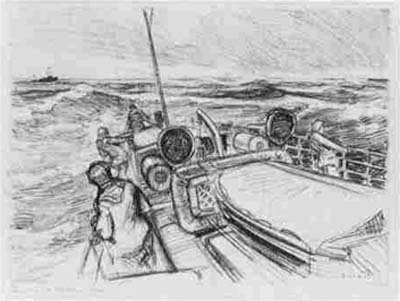
Bulletin 9-10 (V:1-2), 1967
Home
Français
Introduction
History
Annual Index
Author &
Subject
Credits
Contact



Georgian
Bay and the Development
of the September Gale Theme in
Arthur Lismer's Painting, 1912-21
by Barry Lord, Associate Fellow, Dept. of Communications Conestoga
College, Kitchener
Pages 1
| 2 | 3
| 4 | 5 |
6
The National Gallery's A Westerly Gale, Georgian Bay of 1916
(plate 7) (25) is undoubtedly the culminating work in this series,
and the major achievement of Lismer's career before his departure
for Halifax. In it a new complexity and intensity of expression is
reached. The steeply pitched falling foreground with its
indication of the artist's view- point is developed from its
inception in Breezy Weather, Georgian Bay (plate 6);
here it is less dramatic and perhaps less successful, but its
importance for the theme is clearly acknowledged. For this reason
the spatial and volumetric field of reference of September Gale (plate
1) is first anticipated. Also for the first time the foreground
trees are rugged correlatives of the vitality of landscape, weather
and light; compositionally replacing the vertical rock in the
lower left quarter of MacCalIum's Island, Georgian Bay, they
are as yet somewhat hesitant and insubstantial. In the right
foreground the blades of long grass are also discovered, with their
expressive strokes reflecting the inclined verticals of the horizon
of trees; this relationship, much altered and improved, persists in September
Gale
(plate 1). The painter also finds here the dynamic potential of the trees
themselves seen in silhouette against the lowering sky. The source
of light at the horizon far left is a vestigial remnant of the
'rhetorical' preoccupation with sky effects, and the attention to
overall tone with recurring mauve tints is perhaps a last hint of
impressionist influence; but the thickly brushed paint gives the
work a distinctive and authoritative stamp.
In the late summer of 1916 Lismer moved to Halifax, remaining there
until August 1919. Dated 1917, however, is another National Gallery painting,
Georgian
Bay, Spring. (26) Since no return visit is recorded or
remembered,
this large canvas appears to have been worked up from an earlier
sketch or from memory. In its singular essay of a vertical format
and the employment of rather obvious light and colour devices - the
calendar-like horizon and the attention-holding dabs of colour in
the large foreground tree - this work has the marks of a studio
painting distant from time and place of inspiration. In the new
format the trees and the steeply plunging viewpoint are quite
ineffectuel. The painting does, however, indicate clearly the
direction of Lismer's interest in the need for bolder colour and a
striking non-impressionist rendering of light. And for the first
time his clouds take on, however unsuccessfully, that substantive
solidity which hereafter contributes to the structure of his works.
Two sketches by the artist, bequeathed to the National Gallery by Dr
MacCallum, may be associated with these years. (27) One, the panel
entitled Sunset, (28) is another example of the lingering
influence of Constable, both in choice of subject and in the stroked
light rays in the sky; the handling of paint and the brilliant
coloration suggest a date not far from the 1917 Georgian Bay,
Spring. One real advance here is the most successful use compositionally of the horizon silhouette of trees.
Stormy
Sky, (29) the
larger of the two panels, is certainly later since it is painted
with the impasto which the artist developed in his Canadian War
Memorials canvases. The expressive resources of turbulent movement in
the sky are fully realized here, but the lower quarter of the
canvas, with the tentative spit of land and bush in the left corner
and the uncertain viewpoint, shows the painter unable to resolve all the elements of his theme. The impasto and colouring,
particularly the juxtaposition of deep blues in sky and water, make
a 1919-1920 date credible for this painting.
All other extant works of the 1916-1919 period are either views
around the artist's former home at Thornhill, Ontario, or drawings
and paintings around Halifax, most of them done for the Canadian War
Memorials collection. In the Thornhill views the use of impasto
gradually increases, and further explorations of brilliant colour
in strong light are seen. Comparison with Lawren Harris' house and
street paintings suggests itself, but the closest parallel is J. E.
H. MacDonald's Evening, Thornhill, which has recently been
redated to about 1914-17. (30)
In addition to an advance in Lismer's handling of bold colours in
light without half-tones, two of these paintings involve important
discoveries in composition. In the 1916 canvas Afternoon Sunlight,
Thornhill, Ontario, now in the Montreal Museum of Fine
Arts, (31) the sinuous lines of the trees link the horizontal layers
of the composition in a far more interesting and convincing manner
than did the trees in the 1914 Lake in Autumn. Also in the
Montreal Museum painting we see for the first time trees breaking
the top framing edge of the painting; the different sense of space
suggested by this cropping of the trunks and the dynamics of the
sinuous trees and branches are key ideas in the development of
September Gale (plate 1). Here they are used to express the stasis of
winter calm, but by relating them to his earlier work the artist
will be able to assert more satisfactorily the lash of storm and
rain. In another Montreal Museum canvas, Springtime on the Farm, dated
1917 (plate 8), (32) the gnarled 'elbow' bough low on a prominent tree
appears, a direct precursor of similar forms in September Gale (plate
1), and the tree's branches are again allowed to break the top (and
side) framing edges of the painting; because this occurs all across
the top of the picture the result is a simple horizontal spread.
But the artist is developing an idea. There is no direct evidence of
art nouveau derivation in this development, although
doubtless its applications in graphic arts had influenced Lismer.
The weakness of the Thornhill paintings is the artist's frequent
failure to relate planes in space, probably because of his
preoccupation with the colour-light specifics of his subject and the
thickening scumble of his paint surface. By 1918 this scumble had
become a lush impasto and the problems were not resolved. But in one
of the Canadian War Memorials drawings, Looking Astern on a
Sub-Chaser (plate 9), (33) some advances are made in the direction
of September Gale (plate 1). It is interesting that the
extension of the mast to the framing edge is retained in the
well-known canvas, The 'Olympic' with Returned Soldiers. (34) Otherwise,
the Canadian War Memorials works do not represent an important
advance.
Lismer's return to Toronto in August 1919 began a highly creative
period. Three major paintings were executed on the Georgian Bay
subject
within the next two years, while his trips to Algoma with Lawren
Harris and A. Y. Jackson in the spring of 1920 and 1921 introduced
new themes which are not in the scope of this study. The 1920
canvas Rock, Pine and Sunlight, Go Home Bay, now in the Art
Gallery of Ontario, (35) shows Lismer turning aside from the specific
open-water subject we have been studying. Once again, the influence of J. E. H. MacDonald may have been important:
MacDonald's
Autumn Colou, of 1916, (36) also known as Rocks and
Maple, is very
close in subject and treatment to Lismer's panel sketch for the
larger painting. The chief alterations in the finished canvas are
Lismer's characteristic introduction of a vivid foreground and the
horizon silhouette of conifers. Real advances are made, however, in
the artist's ability to state the brilliant but uneven play of
light on his landscape without exaggeration or false drama. The
impasto of 1918 is gone. It is interesting to note that in the
sketch and in another panel study related to this painting, (37) the
trees still go beyond the top framing edge; in the final canvas the
artist discarded this device, undoubtedly in order to gain a
definite balance and monumentality. Lismer's increasing
sophistication is evident.
Next Page | Pine
Tree and Rocks
1
| 2 | 3
| 4 | 5 |
6
Annual Index | Author & Subject | Credits | Contact
This digital collection
was produced under contract to Canada's Digital Collections program,
Industry Canada.
"Digital
Collections Program, Copyright
© National Gallery of
Canada 2001"